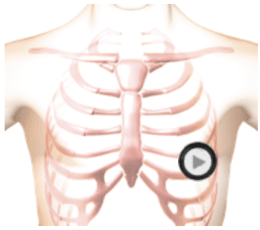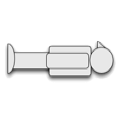Fourth Heart Sound Plus First Heart Sound Auscultation Lesson with Recordings
Virtual Auscultation


The patient's position is supine.
Lesson
Certain heart sound configurations mimic a split first heart sound. One of these conditions is a fourth sound gallop (S4) plus a first heart sound (S1). Since the S4 occurs just before the S1, it is easy to confuse a S4/S1 with a split S1. An S4 is lower frequency than an S1. To differentiate between a S4/S1 and a split S1, listen carefully to the frequency of the initial sound of the pair. If it is lower in frequency than the second sound, it is an S4. If the two sounds are the same, it is a split S1.Waveform
Heart Sounds Video
Authors and Sources
Authors and Reviewers
-
Heart sounds by Dr. Jonathan Keroes, MD and David Lieberman, Developer, Virtual Cardiac Patient.
- Lung sounds by Diane Wrigley, PA
- Respiratory cases: William French
-
David Lieberman, Audio Engineering
-
Heart sounds mentorship by W. Proctor Harvey, MD
- Special thanks for the medical mentorship of Dr. Raymond Murphy
- Reviewed by Dr. Barbara Erickson, PhD, RN, CCRN.
-
Last Update: 12/11/2022
Sources
-
Heart and Lung Sounds Reference Library
Diane S. Wrigley
Publisher: PESI -
Impact Patient Care: Key Physical Assessment Strategies and the Underlying Pathophysiology
Diane S Wrigley & Rosale Lobo - Practical Clinical Skills: Lung Sounds
- Essential Lung Sounds
Diane S. Wrigley, PA-C
Published by MedEdu LLC - PESI Faculty - Diane S Wrigley
-
Case Profiles in Respiratory Care 3rd Ed, 2019
William A.French
Published by Delmar Cengage - Essential Lung Sounds
by William A. French
Published by Cengage Learning, 2011 - Understanding Lung Sounds
Steven Lehrer, MD
- Clinical Heart Disease
W Proctor Harvey, MD
Clinical Heart Disease
Laennec Publishing; 1st edition (January 1, 2009)